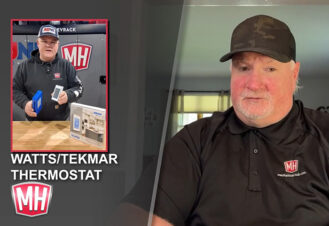You can lead a blind man to the top of Mt. Everest, but you can’t keep a house comfortable with mangled hydronics. Mike O’Donnell aught’a know. Because, in fact, he has lead a blind man to the summit of Mt. Everest. And at home, his dilapidated hydronic system was about as unpleasant as a Himalayan snow squall.
O’Donnell’s renowned climbing career would eventually lead him to guide Erik Weihenmayer to the 29,035-foot Everest summit in May of 2001 – the first blind man to accomplish the unthinkable task. The adventure has since been turned into a book and feature film, “Touch the Top of the World.”
While on a speaking tour to share the details of that expedition, he met Susan Epply. Before too long, they married and now reside in a 10,000 square foot home on the high plains of Southeast Colorado. It sits at the foot of the Rockies on a 500-acre ranch dotted with horses and miniature donkeys. “I designed the home to be functional for children and dogs and the occasional donkey passing through,” said Epply.
As all large undertakings have their challenges, so did the all-hydronic heating system at the ranch. When the home was built in 2001, the original mechanical system sent half of its BTUs to baseboard and half to in-floor radiant loops. Sadly, the 19-zone system wasn’t comfortable; not even close.
In short order, anaerobic bacteria from the property’s well (now abandoned) had ruined most of the original components. The microorganisms were present in water used for the system’s initial fill. To make matters worse, the boiler and piping strategy were ill-suited to meet the needs of a structure of that size.
Problematic piping
According to Epply, Wright Jones was the mechanical contractor of choice when the home was first constructed. At the time, the company was booked solid and couldn’t take on the job. For the second go-round, Epply called the office herself. It proved to be a good decision; by the end of the project, Wright Jones cut her heating bill by over 65 percent.
“When we got the call to renovate and improve the system, I was immediately drawn to the boiler,” said Kenny Gulley, owner of Wright Jones. “A ten-year-old, 180 MBH sectional boiler was struggling to heat the big house while also providing domestic hot water. My first thought was to replace it with a larger Burnham Alpine condensing boiler.”
“Although the undersized boiler was an obvious issue, the key challenge was harder to see. The entire system was contaminated with anaerobic bacteria,” continued Gulley. “They’re a nasty lot – able to survive without oxygen and can easily handle the temperatures inside a boiler.”
Over time, the bacteria thrived. Some components simply couldn’t hold up to the onslaught. Copper pipe and zone valves were literally eaten from the inside out. The boiler, two water heaters and radiant tubing were filled with thick, efficiency-smothering sludge – a byproduct of the single-celled organisms.
After pulling 200 feet of ruined copper out of the mechanical room, the Wright Jones crew installed the new boiler. Mechanically, there were other issues to attend to, as well. System circulators were too small and too few. The in-floor zones simply weren’t getting the flow they needed.
“It was piped old-school,” said Mike Merryman, with McCoy Sales in Littleton, CO, the manufacturer’s rep for the Taco and Burnham products. The supply temp was 180° and was tempered down with mixing valves for the radiant loops.”
Bedroom blizzard
The nine zones of radiant heat were spread across the ground level and upstairs. An additional 10 zones of high-temp fin-tube baseboard were used in the basement and in various rooms upstairs. The master suite, almost 2,000 square feet in size, presented some unique challenges. By order of Epply, the bedroom goes almost unheated while the adjacent bathroom remains at 90°F.
“I keep a snow shovel in the bedroom during the winter,” said Epply. “By leaving my three French doors and six windows wide open, it feels like I’m sleeping outside. If there’s a snow drift beside the bed when I wake up, I just shovel it back outside.”
“I open the room up before I go to bed each night, year around,” continued Epply. “It’s an energy loss I’m willing to tolerate.” The baseboard in the bedroom circulates just enough warmth to keep the pipes from freezing. Yet the master bath – with three exterior walls – continuously calls for heat.
Pumps and piping
Although the heating requirements remained high, limited BTUs and flow rates weren’t an obstacle this time around.
“All zones now tie to a primary-secondary pumping arrangement,” said Gulley. There’s a Taco 0013 for the new condensing Burnham Alpine boiler. A 0011 circulator is used for the domestic tanks and baseboard loops.” The 0011 is a variable speed pump capable of up to 31 GPM, with a head range up to 31 feet.
For the radiant portion of the system, another 0013 circulator provides system flow, installed before the bank of zone valves. The Delta-T circulator turns on when the difference between supply and return temperatures calls for it.
“With the IFC in the circulators, there’s no concern about the high and low temp systems mixing,” said Gulley. The 19 heating zones are controlled by Taco Zone Sentry zone valves and zone control panels.
“Several times – after learning how to drain down the entire system – O’Donnell took the time to swap original plate-style zone valves himself,” said Gulley. “Not anymore. I’m confident that the Zone Sentry’s ball-valve design won’t give out.”
Resilient radiant
“There wasn’t a thing wrong with the radiant tubing, aside from the fact that nothing was labeled when it was installed,” continued Gulley. Over 12,000 feet of ¾-inch Watts EPDM Onyx tubing makes up nine radiant zones. The loops are stapled into the joist bays; five radiant manifolds are scattered throughout the home.
Tearing out and re-installing an entire heating system in an occupied home requires patience from everyone involved – especially in the middle of a Colorado winter. As luck would have it, temperatures dropped below zero and two major snowstorms arrived just after system disassembly.
“It was a good thing that Michael and Susan left for the holidays, because we spent a lot of time turning on zones and waiting to see what got hot,” said Gulley. “Until the system was back together, it was no small task keeping everything sorted out.”
“To get rid of the bacteria, we flushed the system with chlorinated water for five hours. Sterile water was also used to fill the system,” said Gulley. “As soon as the system was turned back on, we had some air noise coming from the in-floor tubing. We purged the lines, and let the Taco 4900 air and dirt separator do its thing, and that was the last we heard of it.”
Because the contaminated well was abandoned, Epply and O’Donnell needed an alternative for the home’s water supply. When the home was built, two 1,500-gallon concrete cisterns were poured under the home. They’d gone unused until the well was abandoned, so all that was needed to fill them up was to call the nearest bulk water company. Today, the cisterns are chlorinated just enough to keep stagnation from becoming an issue.
More BTUs, fewer therms
“The elevation of the home – roughly 6,200 feet – wasn’t helping the poor heating conditions,” said Merryman. As an outside salesman for McCoy, he covers several Rocky Mountain States and routinely encounters situations where efficiency is limited by air density.
“The old boiler ran constantly,” said Gulley. “During the heating season, it drank about $2,000 worth of propane each month.” The solution to the problem came in a smaller package, albeit with larger capacity.
Kenny, Travis, and Master Plumber Drew Macaluso pulled out the old boiler and installed a 285 MBH, 95 percent efficient Burnham Alpine boiler. More than 100 MBH larger than its predecessor, the new boiler is sized properly for the home.
Gulley set up the boiler so that the baseboard and DHW are priority. Plumbed in series, the original 80-gallon indirect water heaters also pull heat from the boiler. After a good cleaning, the units were in good shape. Once the 180° baseboard loops and indirect tanks are satisfied, the boiler turns down to supply water for the Onyx in-floor loops.
“The Alpine was the ticket for this home,” said Gulley. “The entire house isn’t always in use, so it’s nice to have all the capacity if it’s needed, and to scale back if it’s not.”
“Before I called Wright Jones, my December propane bill was $1,560,” said Epply. “After the project, my January bill was $450, February was $510 despite a wicked cold snap, and March was $310.”
Upon completion, the family was able to return to cold bedrooms, hot bathrooms and a smaller heating bill. At night – with snow settling dreamily at the foot of their bed – Epply and O’Donnell can rest assured that the microscopic assault on the mechanical system has come to an end.




Join the conversation: